If you walk through the churchyard, you come to the ruins of Minster Lovell Hall, beautifully located by the River Windrush. Between the ruins and the river are a couple of ponds, where swans browse among the reeds. On the far side is a group of tall, stately trees, whilst beyond the fence, footpaths crisscross uneven meadows. There has been a manor house at Minster Lovell since at least the 12th century, but the major part of the ruins seen today are those of a large new house built by William, Baron of Lovell and Holand, in the 1430s after his return from the French wars. William, one of the richest men in England, built his house as a demonstration of his wealth. William’s son John, a prominent Lancastrian and servant of Henry VI, was rewarded with the position of master forester of the neighbouring royal forest, Wychwood whilst John’s son Francis, the ninth baron, who served the Yorkist cause, was created Viscount Lovell by Richard III.
Following the defeat of the House of York in the battle of Bosworth in 1485 the hall passed into the hands of the Crown and eventually, after being owned by among others Henry VIII’s grooms of the stool, William Compton and Henry Norris, in 1602 into the possession of the lawyer Sir Edward Coke. His descendant Thomas Coke, later Earl of Leicester, in 1728 became Lord Lovell of Minster Lovell. The hall was, however, abandoned in favour of the Cokes’ seat at Holkham, Norfolk, and in about 1747 most of the buildings were dismantled. The buildings are grouped around a central courtyard in a form characteristic of a late medieval manor house – hospitality and control was fundamental to the maintenance of the loyalties on which late medieval English society relied.
The porch to the north wing, approached down a patterned pathway, with its vaulted ceiling, leads to the great hall, the walls of which rise up to twelve meters (39 feet). West of the hall, and separated from it by the width of the room that would formerly have been used as a parlor with a chamber above, lies the northwest building. The east and west walls of this structure still stand. In the 19th century, an attempt to convert it into a barn led to the collapse of the roof, whilst a fireplace in the north wall is evidence of the subsequent construction of a cottage within the walls. North of the hall, ground-floor apartments looking out onto the outer court lay beneath the private chapel on the first floor. A blocked-up gateway indicates the former access from this court to the church.
The east wing of the manor house comprised the stable, kitchen, and other service buildings, and the outline of these structures can still be seen on the ground. The kitchen hearth is still visible in the thick south wall of the kitchen, while close to the west wall is the old well. The stone floor of the stable survives and the wide passage between the stable and the kitchen formed the principal entrance to the courtyard and house.
In the west wing surviving foundations together with stone water tanks and channels suggest that these buildings were later used as a tannery.
The four-story tower at the southwest corner probably dates to the period of Francis Lovell’s ownership in the late 15th century. The dovecote, too, is of the 15th century but can be viewed only from its exterior.
A skeleton surrounded by moldy books and with the remains of a pet dog at its feet was apparently discovered in 1708 in the basement. Reputed to be that of Francis Lovell who had hidden there after the Battle of Stoke, considered by many to be the last battle of the Wars of the Roses, this is thought now to be unlikely as Lovell spent little time at the hall. Legend tells that following defeat at the hands of the Lancastrians, Francis, a Yorkist, hid in a vault giving a servant the only key. However, the servant died shortly after and so Francis died of starvation. An earlier tale maintains that one of William Lovell’s brides disappeared during a game of hide and seek in the Hall on her wedding night. Years later, a servant found the body of a girl dressed in a bridal gown, well preserved in a leaden cool chest used for food storage – presumably, she had hidden in the chest and had been unable to get out.
Minster Lovell Hall


0 Comments